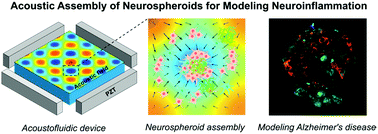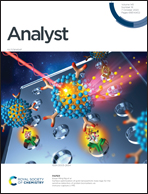Acoustofluidic assembly of 3D neurospheroids to model Alzheimer's disease†
Abstract
Neuroinflammation plays a central role in the progression of many neurodegenerative diseases such as Alzheimer's disease, and challenges remain in modeling the complex pathological or physiological processes. Here, we report an acoustofluidic method that can rapidly construct 3D neurospheroids and inflammatory microenvironments for modeling microglia-mediated neuroinflammation in Alzheimer's disease. By incorporating a unique contactless and label-free acoustic assembly, this cell culture platform can assemble dissociated embryonic mouse brain cells into hundreds of uniform 3D neurospheroids with controlled cell numbers, composition (e.g. neurons, astrocytes, and microglia), and environmental components (e.g. amyloid-β aggregates) in hydrogel within minutes. Moreover, this platform can maintain and monitor the interaction among neurons, astrocytes, microglia, and amyloid-β aggregates in real-time for several days to weeks, after the integration of a high-throughput, time-lapse cell imaging approach. We demonstrated that our engineered 3D neurospheroids can represent the amyloid-β neurotoxicity, which is one of the main pathological features of Alzheimer's disease. Using this method, we also investigated the microglia migratory behaviors and activation in the engineered 3D inflammatory microenvironment at a high throughput manner, which is not easy to achieve in 2D neuronal cultures or animal models. Along with the simple fabrication and setup, the acoustofluidic technology is compatible with conventional Petri dishes and well-plates, supports the fine-tuning of the cellular and environmental components of 3D neurospheroids, and enables the high-throughput cellular interaction investigation. We believe our technology may be widely used to facilitate 3D in vitro brain models for modeling neurodegenerative diseases, discovering new drugs, and testing neurotoxicity.



 Please wait while we load your content...
Please wait while we load your content...
